Clinical Leadership and Management
VerifiedAdded on 2022/11/11
|12
|3368
|475
AI Summary
This article discusses conflict resolution and leadership in healthcare institutions. It includes a case study of a conflict between two nurses and the measures taken to resolve it. The article also covers different types of conflicts, conflict resolution methods, and leadership styles. Recommendations for maintaining peace in hospitals are also provided.
Contribute Materials
Your contribution can guide someone’s learning journey. Share your
documents today.
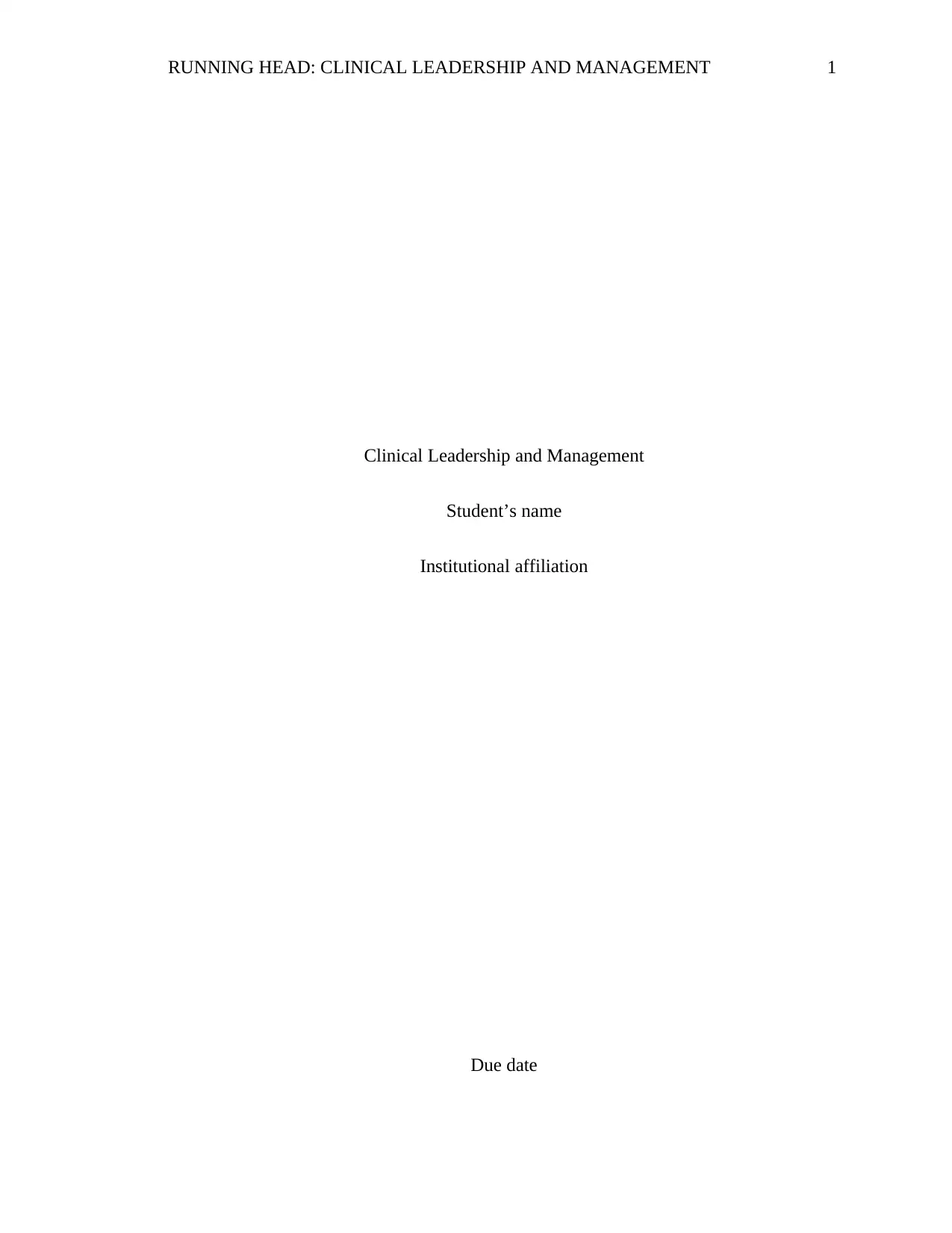
RUNNING HEAD: CLINICAL LEADERSHIP AND MANAGEMENT 1
Clinical Leadership and Management
Student’s name
Institutional affiliation
Due date
Clinical Leadership and Management
Student’s name
Institutional affiliation
Due date
Secure Best Marks with AI Grader
Need help grading? Try our AI Grader for instant feedback on your assignments.
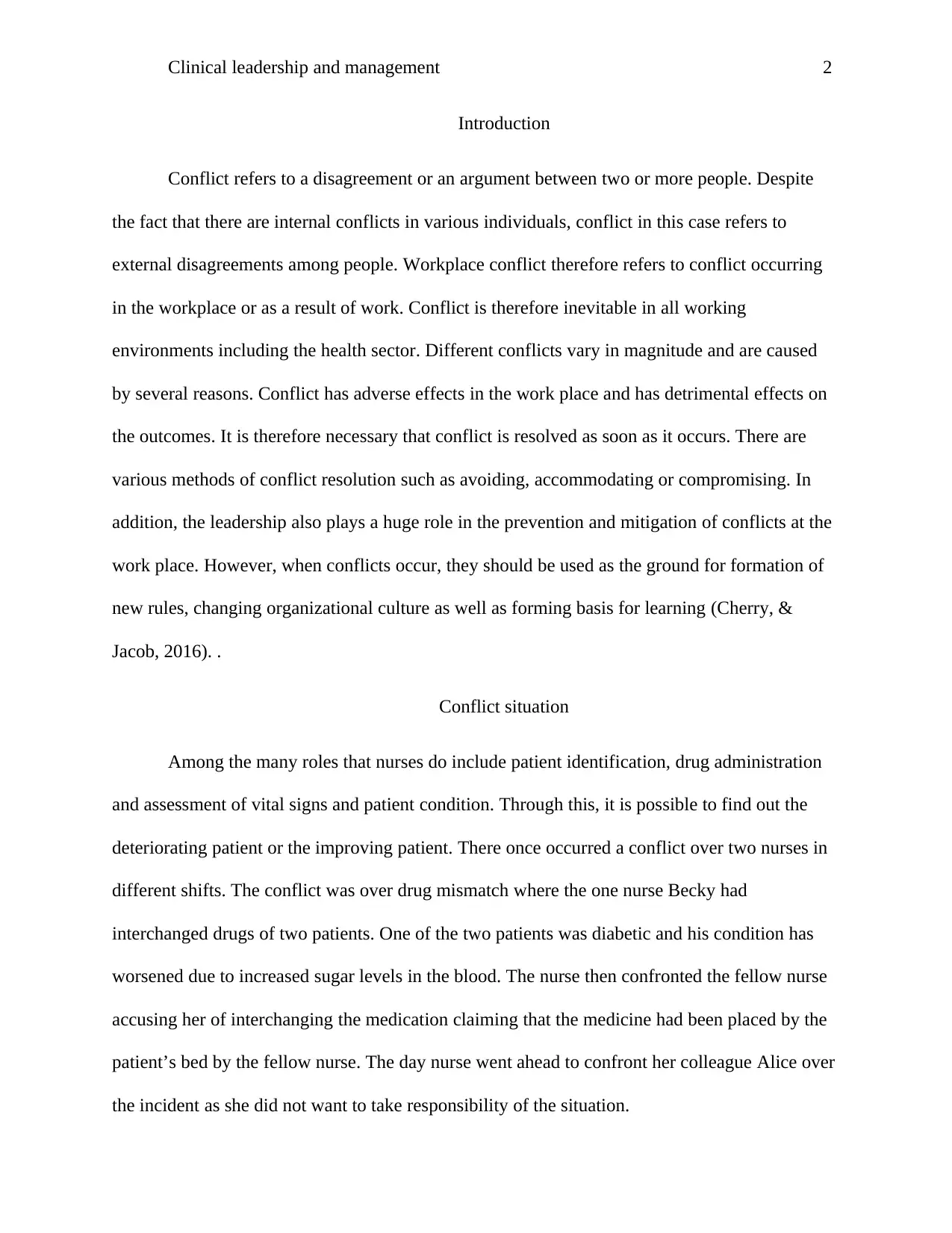
Clinical leadership and management 2
Introduction
Conflict refers to a disagreement or an argument between two or more people. Despite
the fact that there are internal conflicts in various individuals, conflict in this case refers to
external disagreements among people. Workplace conflict therefore refers to conflict occurring
in the workplace or as a result of work. Conflict is therefore inevitable in all working
environments including the health sector. Different conflicts vary in magnitude and are caused
by several reasons. Conflict has adverse effects in the work place and has detrimental effects on
the outcomes. It is therefore necessary that conflict is resolved as soon as it occurs. There are
various methods of conflict resolution such as avoiding, accommodating or compromising. In
addition, the leadership also plays a huge role in the prevention and mitigation of conflicts at the
work place. However, when conflicts occur, they should be used as the ground for formation of
new rules, changing organizational culture as well as forming basis for learning (Cherry, &
Jacob, 2016). .
Conflict situation
Among the many roles that nurses do include patient identification, drug administration
and assessment of vital signs and patient condition. Through this, it is possible to find out the
deteriorating patient or the improving patient. There once occurred a conflict over two nurses in
different shifts. The conflict was over drug mismatch where the one nurse Becky had
interchanged drugs of two patients. One of the two patients was diabetic and his condition has
worsened due to increased sugar levels in the blood. The nurse then confronted the fellow nurse
accusing her of interchanging the medication claiming that the medicine had been placed by the
patient’s bed by the fellow nurse. The day nurse went ahead to confront her colleague Alice over
the incident as she did not want to take responsibility of the situation.
Introduction
Conflict refers to a disagreement or an argument between two or more people. Despite
the fact that there are internal conflicts in various individuals, conflict in this case refers to
external disagreements among people. Workplace conflict therefore refers to conflict occurring
in the workplace or as a result of work. Conflict is therefore inevitable in all working
environments including the health sector. Different conflicts vary in magnitude and are caused
by several reasons. Conflict has adverse effects in the work place and has detrimental effects on
the outcomes. It is therefore necessary that conflict is resolved as soon as it occurs. There are
various methods of conflict resolution such as avoiding, accommodating or compromising. In
addition, the leadership also plays a huge role in the prevention and mitigation of conflicts at the
work place. However, when conflicts occur, they should be used as the ground for formation of
new rules, changing organizational culture as well as forming basis for learning (Cherry, &
Jacob, 2016). .
Conflict situation
Among the many roles that nurses do include patient identification, drug administration
and assessment of vital signs and patient condition. Through this, it is possible to find out the
deteriorating patient or the improving patient. There once occurred a conflict over two nurses in
different shifts. The conflict was over drug mismatch where the one nurse Becky had
interchanged drugs of two patients. One of the two patients was diabetic and his condition has
worsened due to increased sugar levels in the blood. The nurse then confronted the fellow nurse
accusing her of interchanging the medication claiming that the medicine had been placed by the
patient’s bed by the fellow nurse. The day nurse went ahead to confront her colleague Alice over
the incident as she did not want to take responsibility of the situation.
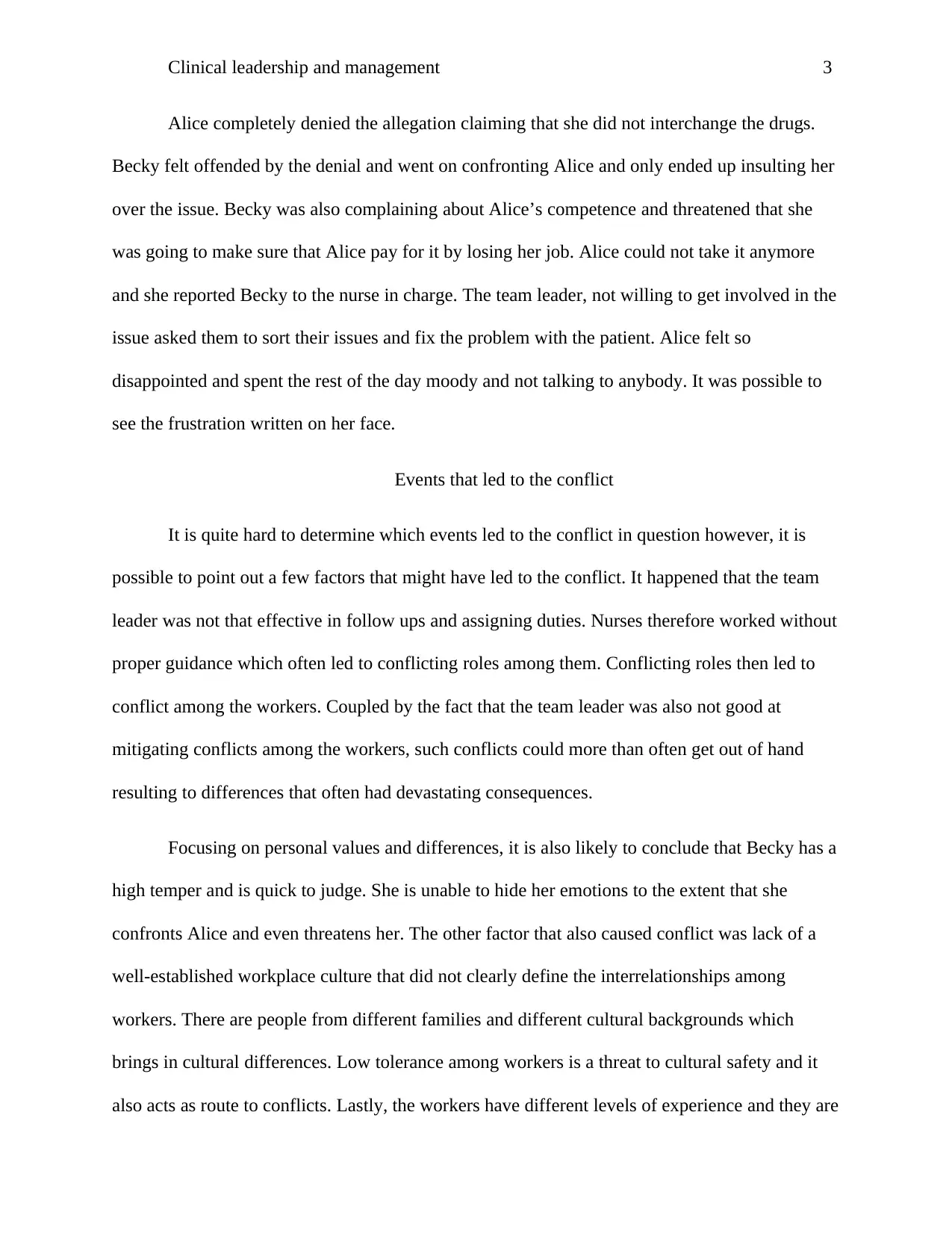
Clinical leadership and management 3
Alice completely denied the allegation claiming that she did not interchange the drugs.
Becky felt offended by the denial and went on confronting Alice and only ended up insulting her
over the issue. Becky was also complaining about Alice’s competence and threatened that she
was going to make sure that Alice pay for it by losing her job. Alice could not take it anymore
and she reported Becky to the nurse in charge. The team leader, not willing to get involved in the
issue asked them to sort their issues and fix the problem with the patient. Alice felt so
disappointed and spent the rest of the day moody and not talking to anybody. It was possible to
see the frustration written on her face.
Events that led to the conflict
It is quite hard to determine which events led to the conflict in question however, it is
possible to point out a few factors that might have led to the conflict. It happened that the team
leader was not that effective in follow ups and assigning duties. Nurses therefore worked without
proper guidance which often led to conflicting roles among them. Conflicting roles then led to
conflict among the workers. Coupled by the fact that the team leader was also not good at
mitigating conflicts among the workers, such conflicts could more than often get out of hand
resulting to differences that often had devastating consequences.
Focusing on personal values and differences, it is also likely to conclude that Becky has a
high temper and is quick to judge. She is unable to hide her emotions to the extent that she
confronts Alice and even threatens her. The other factor that also caused conflict was lack of a
well-established workplace culture that did not clearly define the interrelationships among
workers. There are people from different families and different cultural backgrounds which
brings in cultural differences. Low tolerance among workers is a threat to cultural safety and it
also acts as route to conflicts. Lastly, the workers have different levels of experience and they are
Alice completely denied the allegation claiming that she did not interchange the drugs.
Becky felt offended by the denial and went on confronting Alice and only ended up insulting her
over the issue. Becky was also complaining about Alice’s competence and threatened that she
was going to make sure that Alice pay for it by losing her job. Alice could not take it anymore
and she reported Becky to the nurse in charge. The team leader, not willing to get involved in the
issue asked them to sort their issues and fix the problem with the patient. Alice felt so
disappointed and spent the rest of the day moody and not talking to anybody. It was possible to
see the frustration written on her face.
Events that led to the conflict
It is quite hard to determine which events led to the conflict in question however, it is
possible to point out a few factors that might have led to the conflict. It happened that the team
leader was not that effective in follow ups and assigning duties. Nurses therefore worked without
proper guidance which often led to conflicting roles among them. Conflicting roles then led to
conflict among the workers. Coupled by the fact that the team leader was also not good at
mitigating conflicts among the workers, such conflicts could more than often get out of hand
resulting to differences that often had devastating consequences.
Focusing on personal values and differences, it is also likely to conclude that Becky has a
high temper and is quick to judge. She is unable to hide her emotions to the extent that she
confronts Alice and even threatens her. The other factor that also caused conflict was lack of a
well-established workplace culture that did not clearly define the interrelationships among
workers. There are people from different families and different cultural backgrounds which
brings in cultural differences. Low tolerance among workers is a threat to cultural safety and it
also acts as route to conflicts. Lastly, the workers have different levels of experience and they are
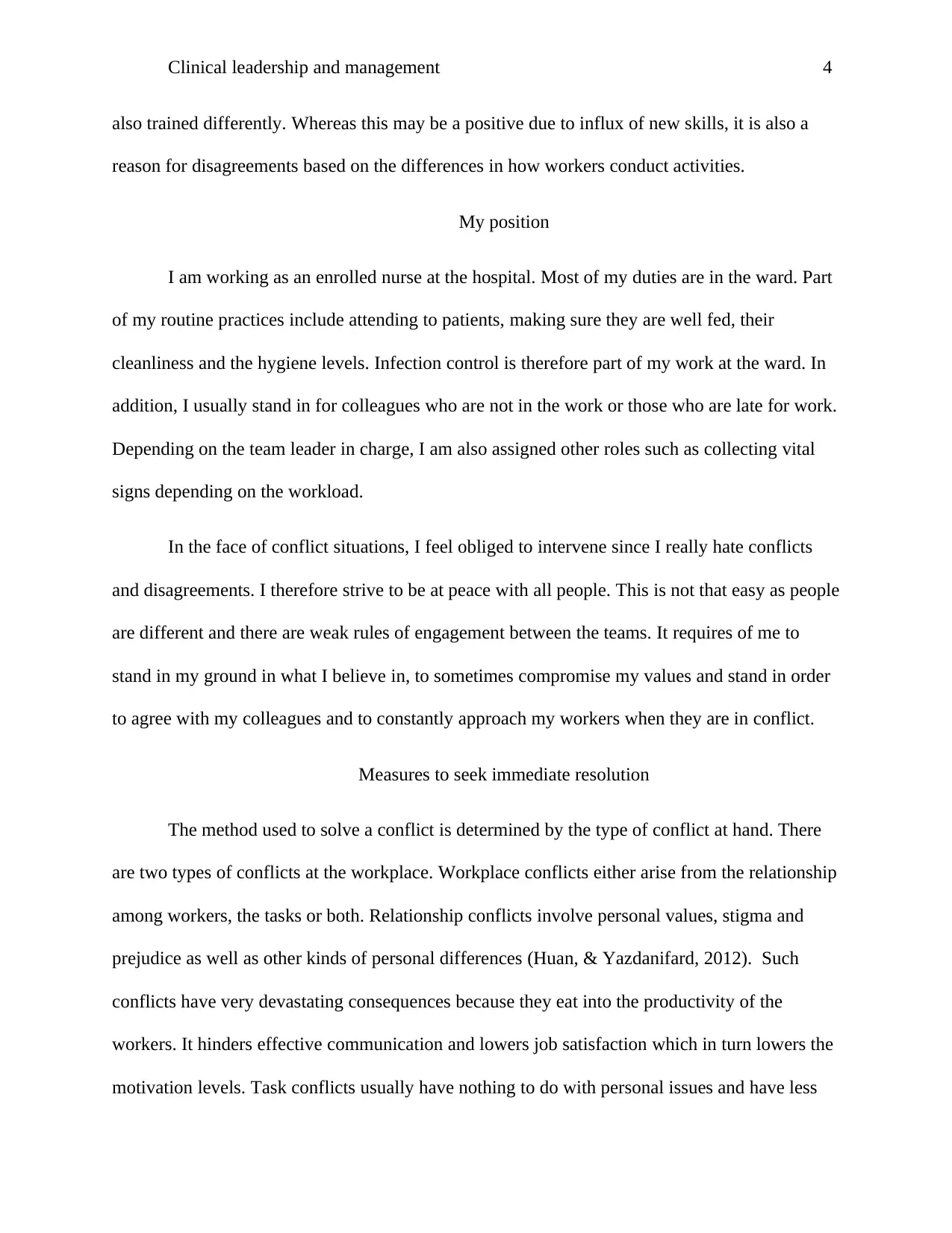
Clinical leadership and management 4
also trained differently. Whereas this may be a positive due to influx of new skills, it is also a
reason for disagreements based on the differences in how workers conduct activities.
My position
I am working as an enrolled nurse at the hospital. Most of my duties are in the ward. Part
of my routine practices include attending to patients, making sure they are well fed, their
cleanliness and the hygiene levels. Infection control is therefore part of my work at the ward. In
addition, I usually stand in for colleagues who are not in the work or those who are late for work.
Depending on the team leader in charge, I am also assigned other roles such as collecting vital
signs depending on the workload.
In the face of conflict situations, I feel obliged to intervene since I really hate conflicts
and disagreements. I therefore strive to be at peace with all people. This is not that easy as people
are different and there are weak rules of engagement between the teams. It requires of me to
stand in my ground in what I believe in, to sometimes compromise my values and stand in order
to agree with my colleagues and to constantly approach my workers when they are in conflict.
Measures to seek immediate resolution
The method used to solve a conflict is determined by the type of conflict at hand. There
are two types of conflicts at the workplace. Workplace conflicts either arise from the relationship
among workers, the tasks or both. Relationship conflicts involve personal values, stigma and
prejudice as well as other kinds of personal differences (Huan, & Yazdanifard, 2012). Such
conflicts have very devastating consequences because they eat into the productivity of the
workers. It hinders effective communication and lowers job satisfaction which in turn lowers the
motivation levels. Task conflicts usually have nothing to do with personal issues and have less
also trained differently. Whereas this may be a positive due to influx of new skills, it is also a
reason for disagreements based on the differences in how workers conduct activities.
My position
I am working as an enrolled nurse at the hospital. Most of my duties are in the ward. Part
of my routine practices include attending to patients, making sure they are well fed, their
cleanliness and the hygiene levels. Infection control is therefore part of my work at the ward. In
addition, I usually stand in for colleagues who are not in the work or those who are late for work.
Depending on the team leader in charge, I am also assigned other roles such as collecting vital
signs depending on the workload.
In the face of conflict situations, I feel obliged to intervene since I really hate conflicts
and disagreements. I therefore strive to be at peace with all people. This is not that easy as people
are different and there are weak rules of engagement between the teams. It requires of me to
stand in my ground in what I believe in, to sometimes compromise my values and stand in order
to agree with my colleagues and to constantly approach my workers when they are in conflict.
Measures to seek immediate resolution
The method used to solve a conflict is determined by the type of conflict at hand. There
are two types of conflicts at the workplace. Workplace conflicts either arise from the relationship
among workers, the tasks or both. Relationship conflicts involve personal values, stigma and
prejudice as well as other kinds of personal differences (Huan, & Yazdanifard, 2012). Such
conflicts have very devastating consequences because they eat into the productivity of the
workers. It hinders effective communication and lowers job satisfaction which in turn lowers the
motivation levels. Task conflicts usually have nothing to do with personal issues and have less
Secure Best Marks with AI Grader
Need help grading? Try our AI Grader for instant feedback on your assignments.
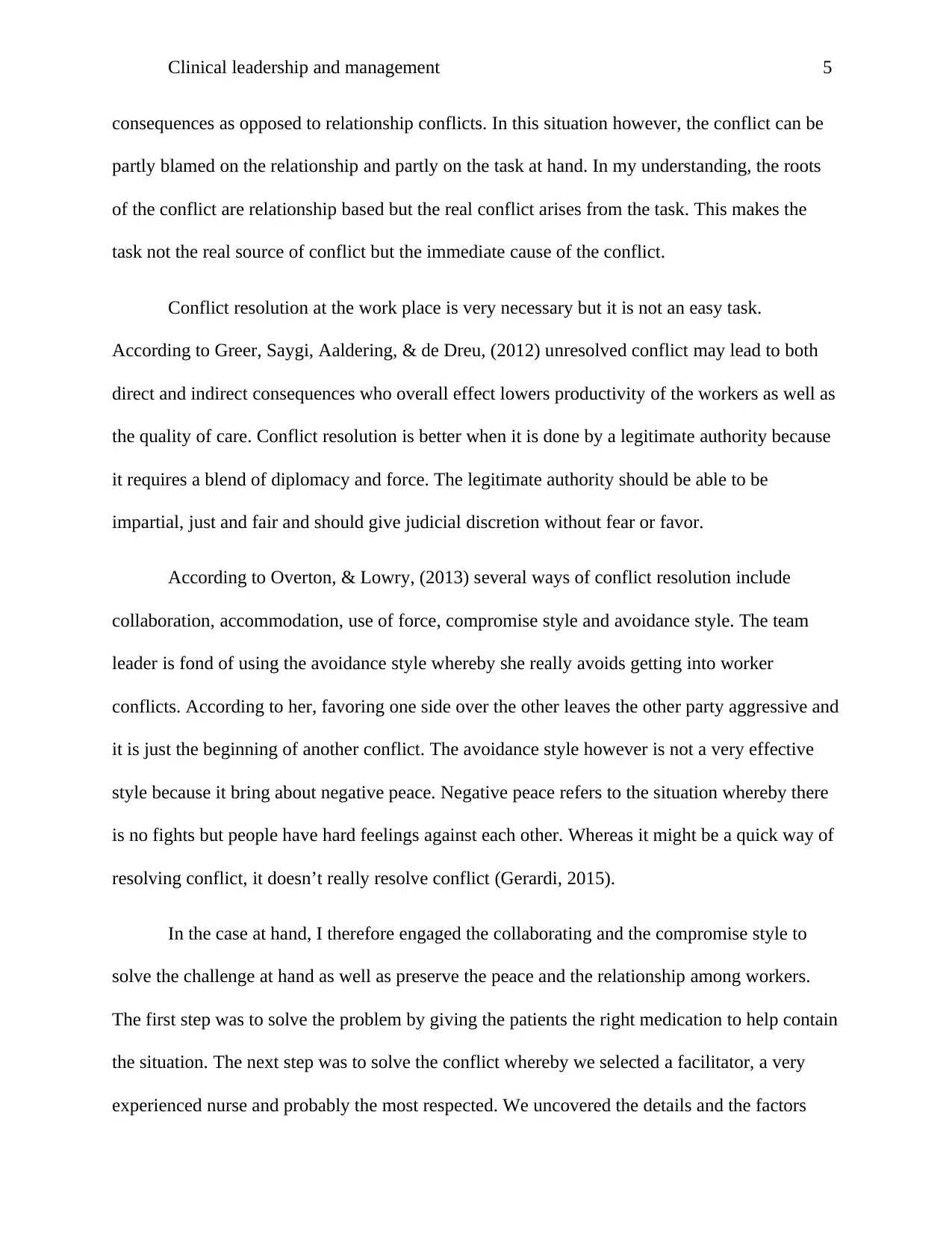
Clinical leadership and management 5
consequences as opposed to relationship conflicts. In this situation however, the conflict can be
partly blamed on the relationship and partly on the task at hand. In my understanding, the roots
of the conflict are relationship based but the real conflict arises from the task. This makes the
task not the real source of conflict but the immediate cause of the conflict.
Conflict resolution at the work place is very necessary but it is not an easy task.
According to Greer, Saygi, Aaldering, & de Dreu, (2012) unresolved conflict may lead to both
direct and indirect consequences who overall effect lowers productivity of the workers as well as
the quality of care. Conflict resolution is better when it is done by a legitimate authority because
it requires a blend of diplomacy and force. The legitimate authority should be able to be
impartial, just and fair and should give judicial discretion without fear or favor.
According to Overton, & Lowry, (2013) several ways of conflict resolution include
collaboration, accommodation, use of force, compromise style and avoidance style. The team
leader is fond of using the avoidance style whereby she really avoids getting into worker
conflicts. According to her, favoring one side over the other leaves the other party aggressive and
it is just the beginning of another conflict. The avoidance style however is not a very effective
style because it bring about negative peace. Negative peace refers to the situation whereby there
is no fights but people have hard feelings against each other. Whereas it might be a quick way of
resolving conflict, it doesn’t really resolve conflict (Gerardi, 2015).
In the case at hand, I therefore engaged the collaborating and the compromise style to
solve the challenge at hand as well as preserve the peace and the relationship among workers.
The first step was to solve the problem by giving the patients the right medication to help contain
the situation. The next step was to solve the conflict whereby we selected a facilitator, a very
experienced nurse and probably the most respected. We uncovered the details and the factors
consequences as opposed to relationship conflicts. In this situation however, the conflict can be
partly blamed on the relationship and partly on the task at hand. In my understanding, the roots
of the conflict are relationship based but the real conflict arises from the task. This makes the
task not the real source of conflict but the immediate cause of the conflict.
Conflict resolution at the work place is very necessary but it is not an easy task.
According to Greer, Saygi, Aaldering, & de Dreu, (2012) unresolved conflict may lead to both
direct and indirect consequences who overall effect lowers productivity of the workers as well as
the quality of care. Conflict resolution is better when it is done by a legitimate authority because
it requires a blend of diplomacy and force. The legitimate authority should be able to be
impartial, just and fair and should give judicial discretion without fear or favor.
According to Overton, & Lowry, (2013) several ways of conflict resolution include
collaboration, accommodation, use of force, compromise style and avoidance style. The team
leader is fond of using the avoidance style whereby she really avoids getting into worker
conflicts. According to her, favoring one side over the other leaves the other party aggressive and
it is just the beginning of another conflict. The avoidance style however is not a very effective
style because it bring about negative peace. Negative peace refers to the situation whereby there
is no fights but people have hard feelings against each other. Whereas it might be a quick way of
resolving conflict, it doesn’t really resolve conflict (Gerardi, 2015).
In the case at hand, I therefore engaged the collaborating and the compromise style to
solve the challenge at hand as well as preserve the peace and the relationship among workers.
The first step was to solve the problem by giving the patients the right medication to help contain
the situation. The next step was to solve the conflict whereby we selected a facilitator, a very
experienced nurse and probably the most respected. We uncovered the details and the factors
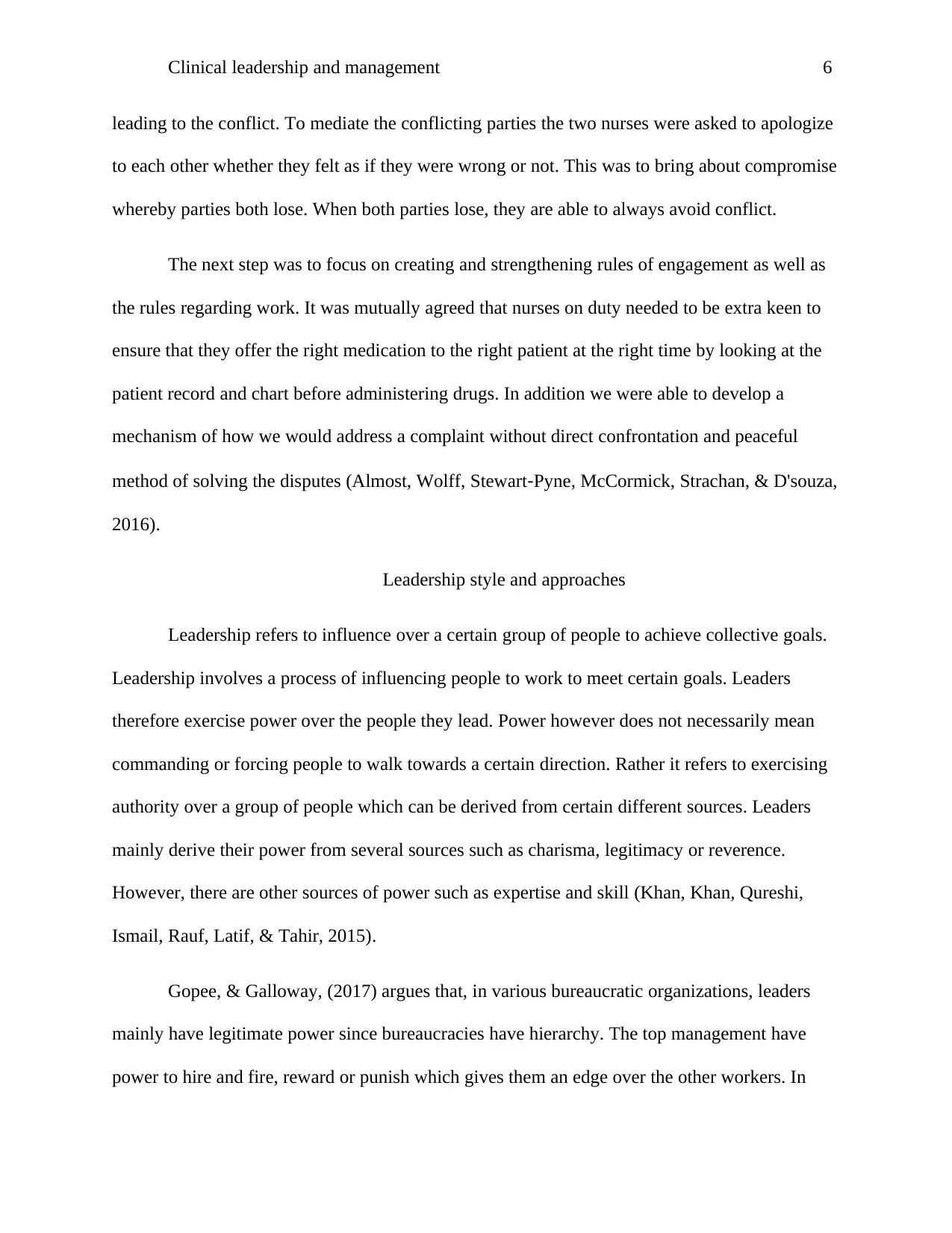
Clinical leadership and management 6
leading to the conflict. To mediate the conflicting parties the two nurses were asked to apologize
to each other whether they felt as if they were wrong or not. This was to bring about compromise
whereby parties both lose. When both parties lose, they are able to always avoid conflict.
The next step was to focus on creating and strengthening rules of engagement as well as
the rules regarding work. It was mutually agreed that nurses on duty needed to be extra keen to
ensure that they offer the right medication to the right patient at the right time by looking at the
patient record and chart before administering drugs. In addition we were able to develop a
mechanism of how we would address a complaint without direct confrontation and peaceful
method of solving the disputes (Almost, Wolff, Stewart‐Pyne, McCormick, Strachan, & D'souza,
2016).
Leadership style and approaches
Leadership refers to influence over a certain group of people to achieve collective goals.
Leadership involves a process of influencing people to work to meet certain goals. Leaders
therefore exercise power over the people they lead. Power however does not necessarily mean
commanding or forcing people to walk towards a certain direction. Rather it refers to exercising
authority over a group of people which can be derived from certain different sources. Leaders
mainly derive their power from several sources such as charisma, legitimacy or reverence.
However, there are other sources of power such as expertise and skill (Khan, Khan, Qureshi,
Ismail, Rauf, Latif, & Tahir, 2015).
Gopee, & Galloway, (2017) argues that, in various bureaucratic organizations, leaders
mainly have legitimate power since bureaucracies have hierarchy. The top management have
power to hire and fire, reward or punish which gives them an edge over the other workers. In
leading to the conflict. To mediate the conflicting parties the two nurses were asked to apologize
to each other whether they felt as if they were wrong or not. This was to bring about compromise
whereby parties both lose. When both parties lose, they are able to always avoid conflict.
The next step was to focus on creating and strengthening rules of engagement as well as
the rules regarding work. It was mutually agreed that nurses on duty needed to be extra keen to
ensure that they offer the right medication to the right patient at the right time by looking at the
patient record and chart before administering drugs. In addition we were able to develop a
mechanism of how we would address a complaint without direct confrontation and peaceful
method of solving the disputes (Almost, Wolff, Stewart‐Pyne, McCormick, Strachan, & D'souza,
2016).
Leadership style and approaches
Leadership refers to influence over a certain group of people to achieve collective goals.
Leadership involves a process of influencing people to work to meet certain goals. Leaders
therefore exercise power over the people they lead. Power however does not necessarily mean
commanding or forcing people to walk towards a certain direction. Rather it refers to exercising
authority over a group of people which can be derived from certain different sources. Leaders
mainly derive their power from several sources such as charisma, legitimacy or reverence.
However, there are other sources of power such as expertise and skill (Khan, Khan, Qureshi,
Ismail, Rauf, Latif, & Tahir, 2015).
Gopee, & Galloway, (2017) argues that, in various bureaucratic organizations, leaders
mainly have legitimate power since bureaucracies have hierarchy. The top management have
power to hire and fire, reward or punish which gives them an edge over the other workers. In
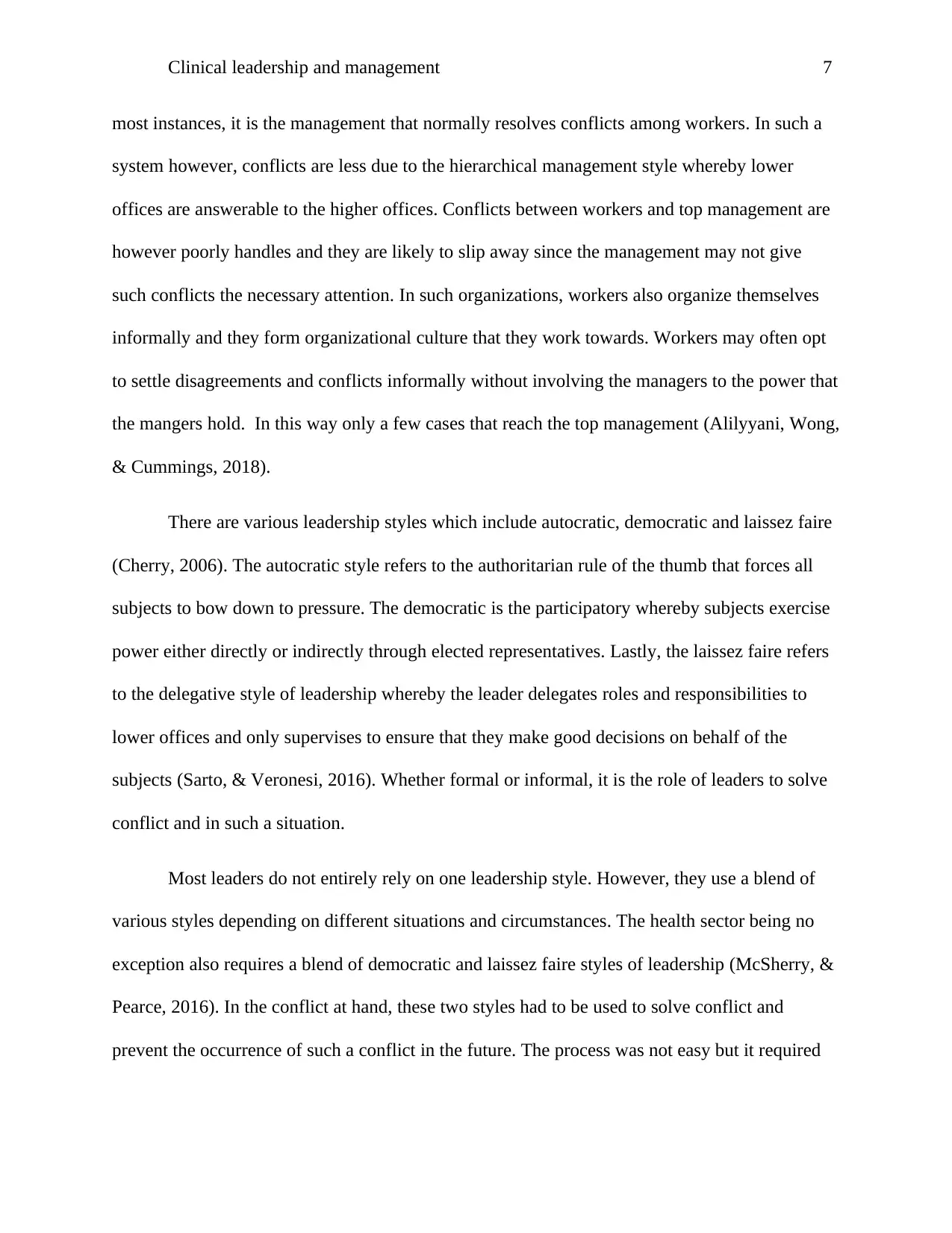
Clinical leadership and management 7
most instances, it is the management that normally resolves conflicts among workers. In such a
system however, conflicts are less due to the hierarchical management style whereby lower
offices are answerable to the higher offices. Conflicts between workers and top management are
however poorly handles and they are likely to slip away since the management may not give
such conflicts the necessary attention. In such organizations, workers also organize themselves
informally and they form organizational culture that they work towards. Workers may often opt
to settle disagreements and conflicts informally without involving the managers to the power that
the mangers hold. In this way only a few cases that reach the top management (Alilyyani, Wong,
& Cummings, 2018).
There are various leadership styles which include autocratic, democratic and laissez faire
(Cherry, 2006). The autocratic style refers to the authoritarian rule of the thumb that forces all
subjects to bow down to pressure. The democratic is the participatory whereby subjects exercise
power either directly or indirectly through elected representatives. Lastly, the laissez faire refers
to the delegative style of leadership whereby the leader delegates roles and responsibilities to
lower offices and only supervises to ensure that they make good decisions on behalf of the
subjects (Sarto, & Veronesi, 2016). Whether formal or informal, it is the role of leaders to solve
conflict and in such a situation.
Most leaders do not entirely rely on one leadership style. However, they use a blend of
various styles depending on different situations and circumstances. The health sector being no
exception also requires a blend of democratic and laissez faire styles of leadership (McSherry, &
Pearce, 2016). In the conflict at hand, these two styles had to be used to solve conflict and
prevent the occurrence of such a conflict in the future. The process was not easy but it required
most instances, it is the management that normally resolves conflicts among workers. In such a
system however, conflicts are less due to the hierarchical management style whereby lower
offices are answerable to the higher offices. Conflicts between workers and top management are
however poorly handles and they are likely to slip away since the management may not give
such conflicts the necessary attention. In such organizations, workers also organize themselves
informally and they form organizational culture that they work towards. Workers may often opt
to settle disagreements and conflicts informally without involving the managers to the power that
the mangers hold. In this way only a few cases that reach the top management (Alilyyani, Wong,
& Cummings, 2018).
There are various leadership styles which include autocratic, democratic and laissez faire
(Cherry, 2006). The autocratic style refers to the authoritarian rule of the thumb that forces all
subjects to bow down to pressure. The democratic is the participatory whereby subjects exercise
power either directly or indirectly through elected representatives. Lastly, the laissez faire refers
to the delegative style of leadership whereby the leader delegates roles and responsibilities to
lower offices and only supervises to ensure that they make good decisions on behalf of the
subjects (Sarto, & Veronesi, 2016). Whether formal or informal, it is the role of leaders to solve
conflict and in such a situation.
Most leaders do not entirely rely on one leadership style. However, they use a blend of
various styles depending on different situations and circumstances. The health sector being no
exception also requires a blend of democratic and laissez faire styles of leadership (McSherry, &
Pearce, 2016). In the conflict at hand, these two styles had to be used to solve conflict and
prevent the occurrence of such a conflict in the future. The process was not easy but it required
Paraphrase This Document
Need a fresh take? Get an instant paraphrase of this document with our AI Paraphraser
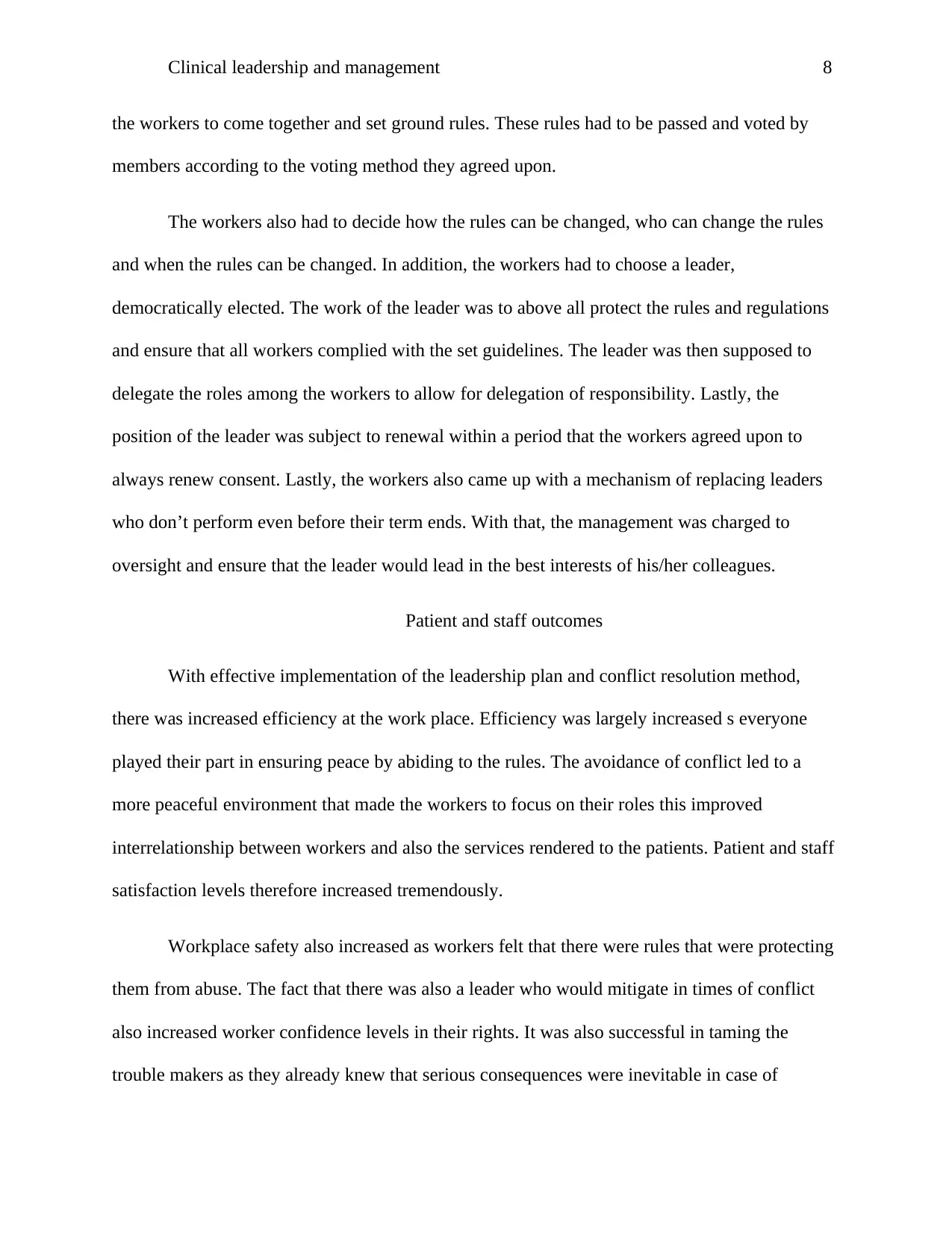
Clinical leadership and management 8
the workers to come together and set ground rules. These rules had to be passed and voted by
members according to the voting method they agreed upon.
The workers also had to decide how the rules can be changed, who can change the rules
and when the rules can be changed. In addition, the workers had to choose a leader,
democratically elected. The work of the leader was to above all protect the rules and regulations
and ensure that all workers complied with the set guidelines. The leader was then supposed to
delegate the roles among the workers to allow for delegation of responsibility. Lastly, the
position of the leader was subject to renewal within a period that the workers agreed upon to
always renew consent. Lastly, the workers also came up with a mechanism of replacing leaders
who don’t perform even before their term ends. With that, the management was charged to
oversight and ensure that the leader would lead in the best interests of his/her colleagues.
Patient and staff outcomes
With effective implementation of the leadership plan and conflict resolution method,
there was increased efficiency at the work place. Efficiency was largely increased s everyone
played their part in ensuring peace by abiding to the rules. The avoidance of conflict led to a
more peaceful environment that made the workers to focus on their roles this improved
interrelationship between workers and also the services rendered to the patients. Patient and staff
satisfaction levels therefore increased tremendously.
Workplace safety also increased as workers felt that there were rules that were protecting
them from abuse. The fact that there was also a leader who would mitigate in times of conflict
also increased worker confidence levels in their rights. It was also successful in taming the
trouble makers as they already knew that serious consequences were inevitable in case of
the workers to come together and set ground rules. These rules had to be passed and voted by
members according to the voting method they agreed upon.
The workers also had to decide how the rules can be changed, who can change the rules
and when the rules can be changed. In addition, the workers had to choose a leader,
democratically elected. The work of the leader was to above all protect the rules and regulations
and ensure that all workers complied with the set guidelines. The leader was then supposed to
delegate the roles among the workers to allow for delegation of responsibility. Lastly, the
position of the leader was subject to renewal within a period that the workers agreed upon to
always renew consent. Lastly, the workers also came up with a mechanism of replacing leaders
who don’t perform even before their term ends. With that, the management was charged to
oversight and ensure that the leader would lead in the best interests of his/her colleagues.
Patient and staff outcomes
With effective implementation of the leadership plan and conflict resolution method,
there was increased efficiency at the work place. Efficiency was largely increased s everyone
played their part in ensuring peace by abiding to the rules. The avoidance of conflict led to a
more peaceful environment that made the workers to focus on their roles this improved
interrelationship between workers and also the services rendered to the patients. Patient and staff
satisfaction levels therefore increased tremendously.
Workplace safety also increased as workers felt that there were rules that were protecting
them from abuse. The fact that there was also a leader who would mitigate in times of conflict
also increased worker confidence levels in their rights. It was also successful in taming the
trouble makers as they already knew that serious consequences were inevitable in case of
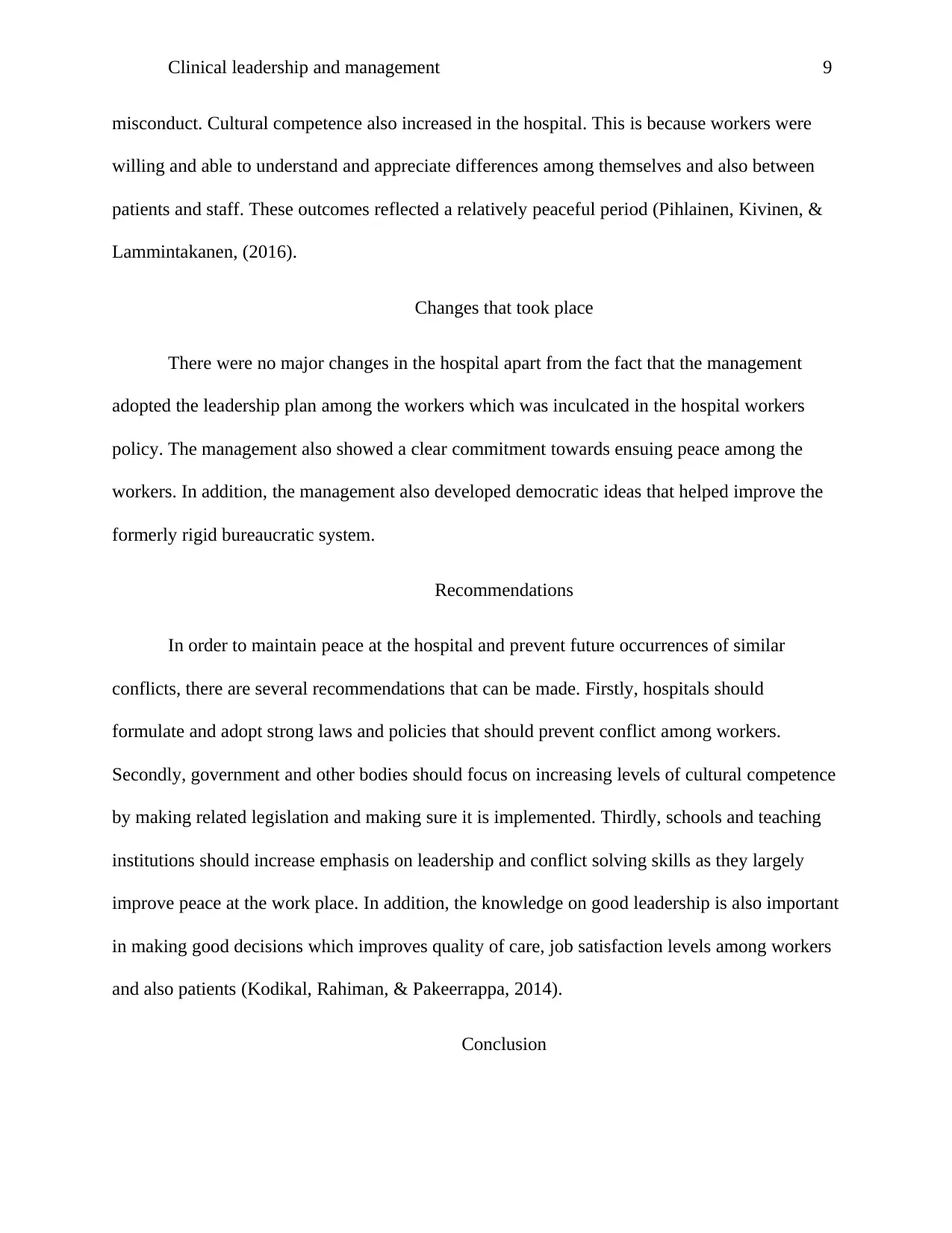
Clinical leadership and management 9
misconduct. Cultural competence also increased in the hospital. This is because workers were
willing and able to understand and appreciate differences among themselves and also between
patients and staff. These outcomes reflected a relatively peaceful period (Pihlainen, Kivinen, &
Lammintakanen, (2016).
Changes that took place
There were no major changes in the hospital apart from the fact that the management
adopted the leadership plan among the workers which was inculcated in the hospital workers
policy. The management also showed a clear commitment towards ensuing peace among the
workers. In addition, the management also developed democratic ideas that helped improve the
formerly rigid bureaucratic system.
Recommendations
In order to maintain peace at the hospital and prevent future occurrences of similar
conflicts, there are several recommendations that can be made. Firstly, hospitals should
formulate and adopt strong laws and policies that should prevent conflict among workers.
Secondly, government and other bodies should focus on increasing levels of cultural competence
by making related legislation and making sure it is implemented. Thirdly, schools and teaching
institutions should increase emphasis on leadership and conflict solving skills as they largely
improve peace at the work place. In addition, the knowledge on good leadership is also important
in making good decisions which improves quality of care, job satisfaction levels among workers
and also patients (Kodikal, Rahiman, & Pakeerrappa, 2014).
Conclusion
misconduct. Cultural competence also increased in the hospital. This is because workers were
willing and able to understand and appreciate differences among themselves and also between
patients and staff. These outcomes reflected a relatively peaceful period (Pihlainen, Kivinen, &
Lammintakanen, (2016).
Changes that took place
There were no major changes in the hospital apart from the fact that the management
adopted the leadership plan among the workers which was inculcated in the hospital workers
policy. The management also showed a clear commitment towards ensuing peace among the
workers. In addition, the management also developed democratic ideas that helped improve the
formerly rigid bureaucratic system.
Recommendations
In order to maintain peace at the hospital and prevent future occurrences of similar
conflicts, there are several recommendations that can be made. Firstly, hospitals should
formulate and adopt strong laws and policies that should prevent conflict among workers.
Secondly, government and other bodies should focus on increasing levels of cultural competence
by making related legislation and making sure it is implemented. Thirdly, schools and teaching
institutions should increase emphasis on leadership and conflict solving skills as they largely
improve peace at the work place. In addition, the knowledge on good leadership is also important
in making good decisions which improves quality of care, job satisfaction levels among workers
and also patients (Kodikal, Rahiman, & Pakeerrappa, 2014).
Conclusion
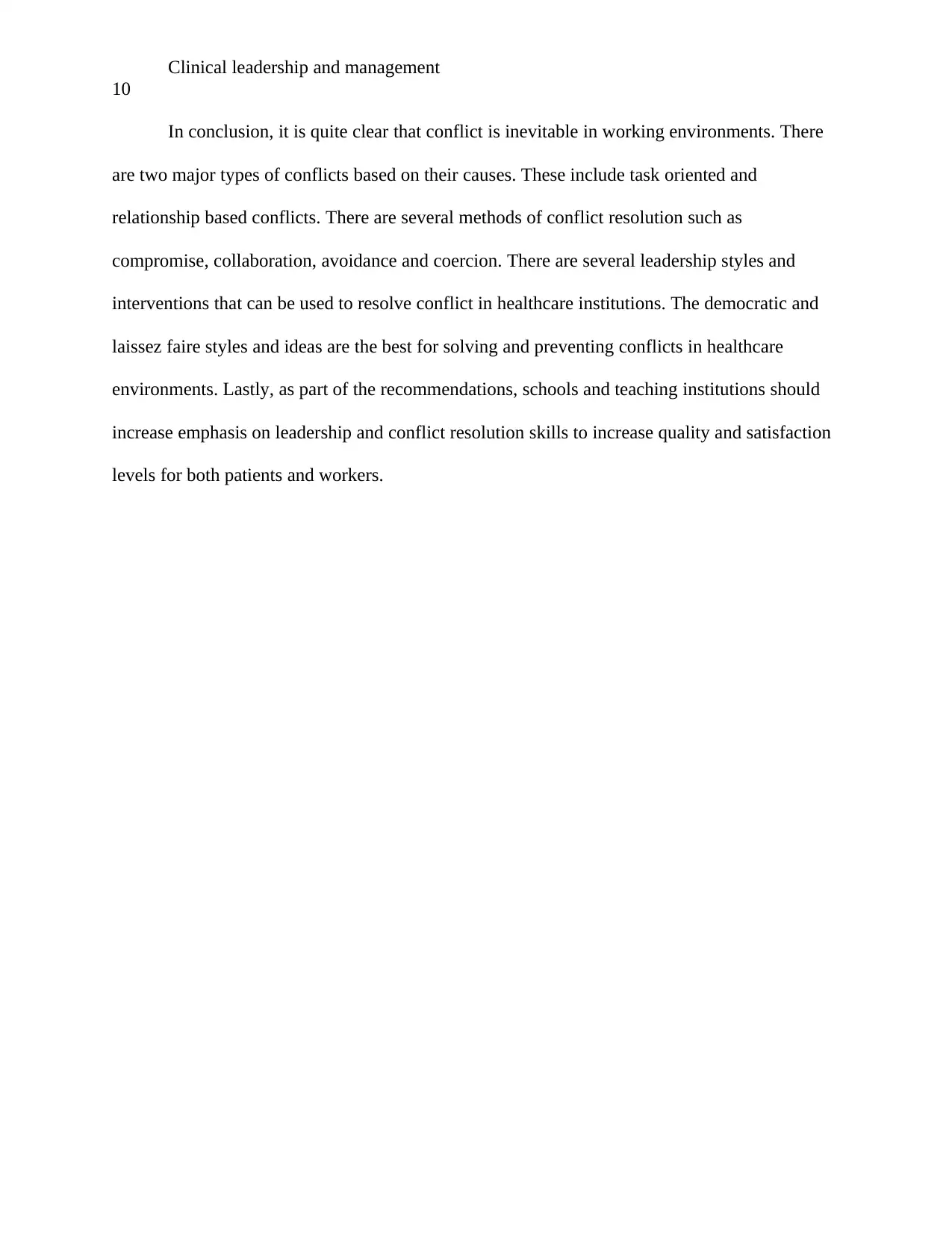
Clinical leadership and management
10
In conclusion, it is quite clear that conflict is inevitable in working environments. There
are two major types of conflicts based on their causes. These include task oriented and
relationship based conflicts. There are several methods of conflict resolution such as
compromise, collaboration, avoidance and coercion. There are several leadership styles and
interventions that can be used to resolve conflict in healthcare institutions. The democratic and
laissez faire styles and ideas are the best for solving and preventing conflicts in healthcare
environments. Lastly, as part of the recommendations, schools and teaching institutions should
increase emphasis on leadership and conflict resolution skills to increase quality and satisfaction
levels for both patients and workers.
10
In conclusion, it is quite clear that conflict is inevitable in working environments. There
are two major types of conflicts based on their causes. These include task oriented and
relationship based conflicts. There are several methods of conflict resolution such as
compromise, collaboration, avoidance and coercion. There are several leadership styles and
interventions that can be used to resolve conflict in healthcare institutions. The democratic and
laissez faire styles and ideas are the best for solving and preventing conflicts in healthcare
environments. Lastly, as part of the recommendations, schools and teaching institutions should
increase emphasis on leadership and conflict resolution skills to increase quality and satisfaction
levels for both patients and workers.
Secure Best Marks with AI Grader
Need help grading? Try our AI Grader for instant feedback on your assignments.
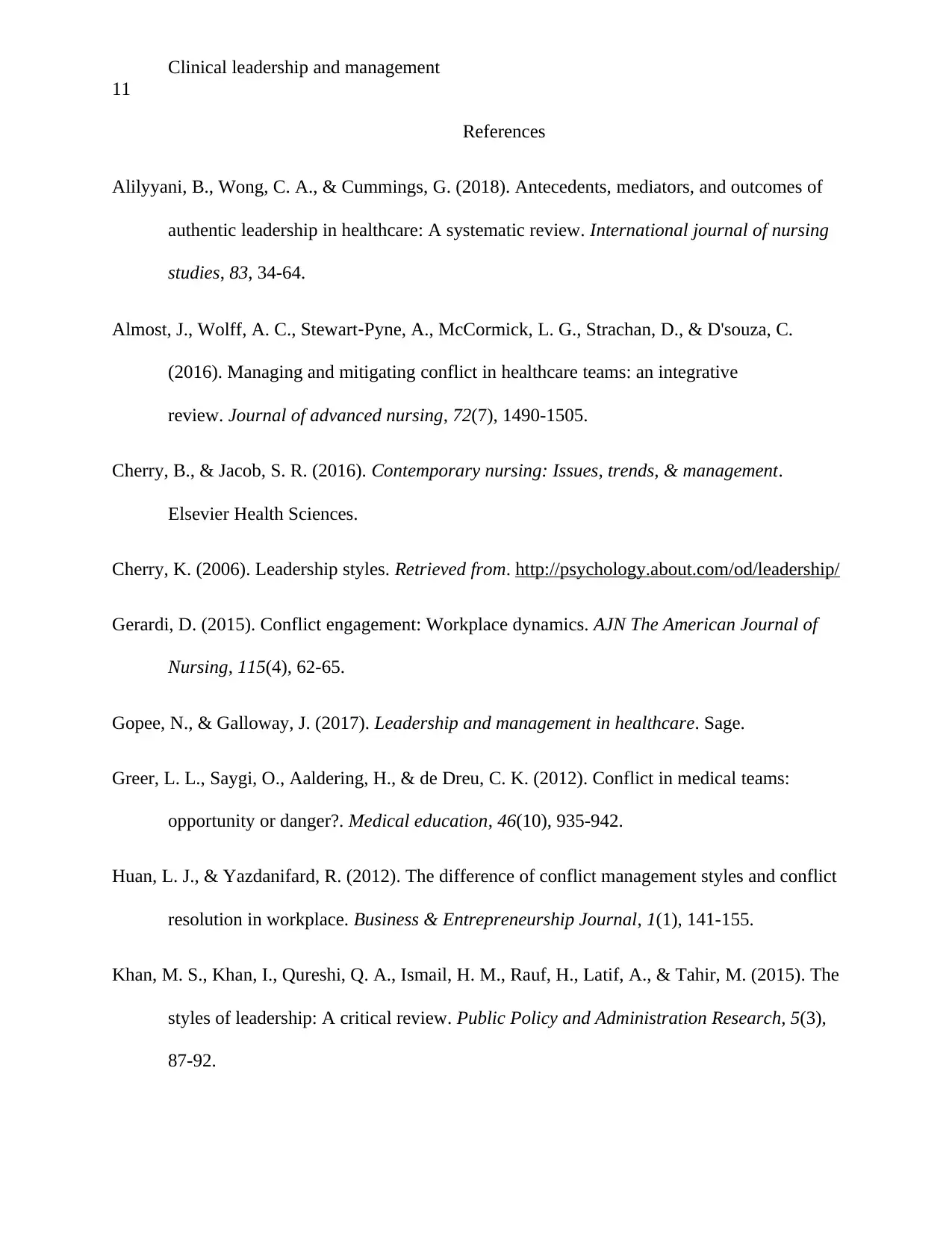
Clinical leadership and management
11
References
Alilyyani, B., Wong, C. A., & Cummings, G. (2018). Antecedents, mediators, and outcomes of
authentic leadership in healthcare: A systematic review. International journal of nursing
studies, 83, 34-64.
Almost, J., Wolff, A. C., Stewart‐Pyne, A., McCormick, L. G., Strachan, D., & D'souza, C.
(2016). Managing and mitigating conflict in healthcare teams: an integrative
review. Journal of advanced nursing, 72(7), 1490-1505.
Cherry, B., & Jacob, S. R. (2016). Contemporary nursing: Issues, trends, & management.
Elsevier Health Sciences.
Cherry, K. (2006). Leadership styles. Retrieved from. http://psychology.about.com/od/leadership/
Gerardi, D. (2015). Conflict engagement: Workplace dynamics. AJN The American Journal of
Nursing, 115(4), 62-65.
Gopee, N., & Galloway, J. (2017). Leadership and management in healthcare. Sage.
Greer, L. L., Saygi, O., Aaldering, H., & de Dreu, C. K. (2012). Conflict in medical teams:
opportunity or danger?. Medical education, 46(10), 935-942.
Huan, L. J., & Yazdanifard, R. (2012). The difference of conflict management styles and conflict
resolution in workplace. Business & Entrepreneurship Journal, 1(1), 141-155.
Khan, M. S., Khan, I., Qureshi, Q. A., Ismail, H. M., Rauf, H., Latif, A., & Tahir, M. (2015). The
styles of leadership: A critical review. Public Policy and Administration Research, 5(3),
87-92.
11
References
Alilyyani, B., Wong, C. A., & Cummings, G. (2018). Antecedents, mediators, and outcomes of
authentic leadership in healthcare: A systematic review. International journal of nursing
studies, 83, 34-64.
Almost, J., Wolff, A. C., Stewart‐Pyne, A., McCormick, L. G., Strachan, D., & D'souza, C.
(2016). Managing and mitigating conflict in healthcare teams: an integrative
review. Journal of advanced nursing, 72(7), 1490-1505.
Cherry, B., & Jacob, S. R. (2016). Contemporary nursing: Issues, trends, & management.
Elsevier Health Sciences.
Cherry, K. (2006). Leadership styles. Retrieved from. http://psychology.about.com/od/leadership/
Gerardi, D. (2015). Conflict engagement: Workplace dynamics. AJN The American Journal of
Nursing, 115(4), 62-65.
Gopee, N., & Galloway, J. (2017). Leadership and management in healthcare. Sage.
Greer, L. L., Saygi, O., Aaldering, H., & de Dreu, C. K. (2012). Conflict in medical teams:
opportunity or danger?. Medical education, 46(10), 935-942.
Huan, L. J., & Yazdanifard, R. (2012). The difference of conflict management styles and conflict
resolution in workplace. Business & Entrepreneurship Journal, 1(1), 141-155.
Khan, M. S., Khan, I., Qureshi, Q. A., Ismail, H. M., Rauf, H., Latif, A., & Tahir, M. (2015). The
styles of leadership: A critical review. Public Policy and Administration Research, 5(3),
87-92.
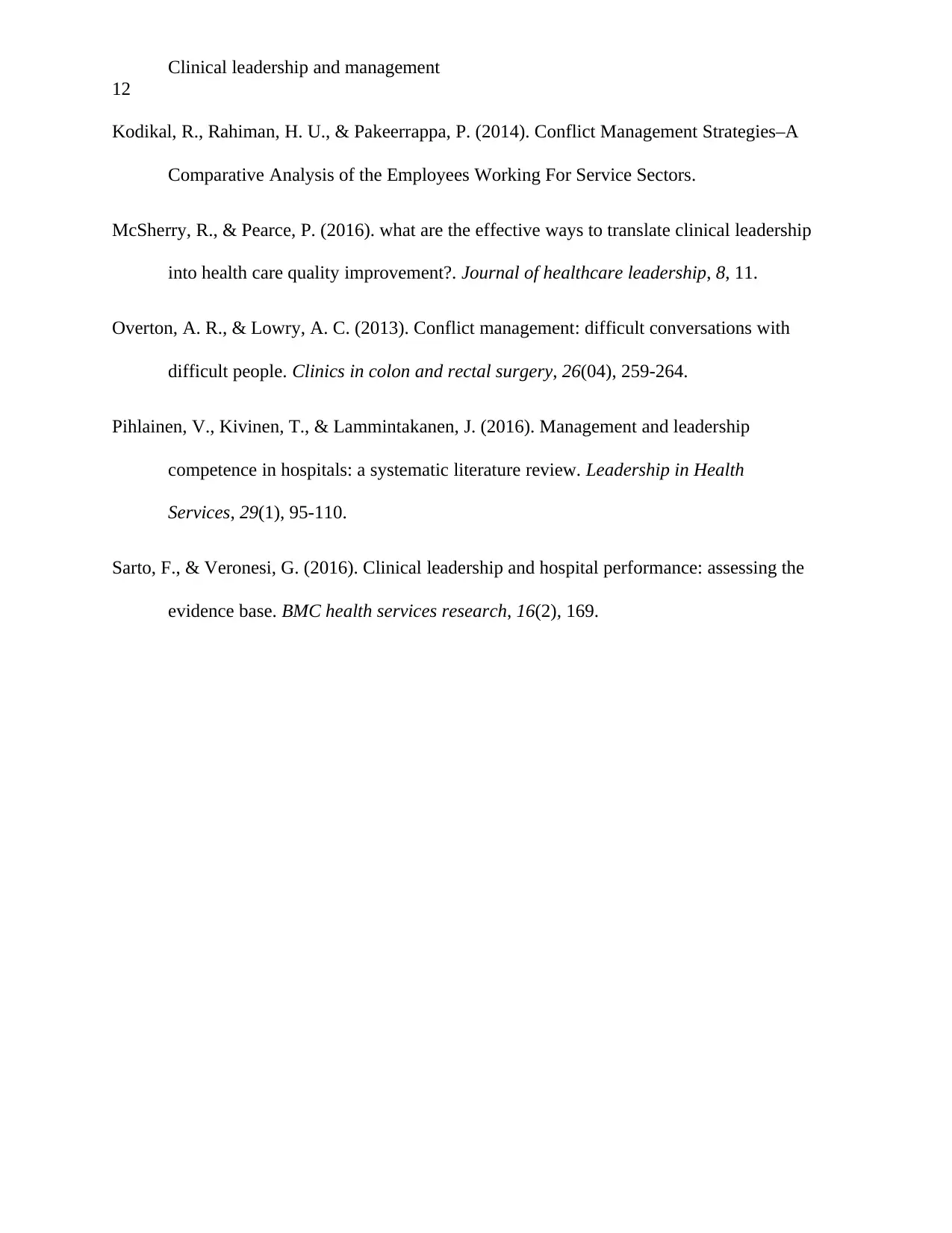
Clinical leadership and management
12
Kodikal, R., Rahiman, H. U., & Pakeerrappa, P. (2014). Conflict Management Strategies–A
Comparative Analysis of the Employees Working For Service Sectors.
McSherry, R., & Pearce, P. (2016). what are the effective ways to translate clinical leadership
into health care quality improvement?. Journal of healthcare leadership, 8, 11.
Overton, A. R., & Lowry, A. C. (2013). Conflict management: difficult conversations with
difficult people. Clinics in colon and rectal surgery, 26(04), 259-264.
Pihlainen, V., Kivinen, T., & Lammintakanen, J. (2016). Management and leadership
competence in hospitals: a systematic literature review. Leadership in Health
Services, 29(1), 95-110.
Sarto, F., & Veronesi, G. (2016). Clinical leadership and hospital performance: assessing the
evidence base. BMC health services research, 16(2), 169.
12
Kodikal, R., Rahiman, H. U., & Pakeerrappa, P. (2014). Conflict Management Strategies–A
Comparative Analysis of the Employees Working For Service Sectors.
McSherry, R., & Pearce, P. (2016). what are the effective ways to translate clinical leadership
into health care quality improvement?. Journal of healthcare leadership, 8, 11.
Overton, A. R., & Lowry, A. C. (2013). Conflict management: difficult conversations with
difficult people. Clinics in colon and rectal surgery, 26(04), 259-264.
Pihlainen, V., Kivinen, T., & Lammintakanen, J. (2016). Management and leadership
competence in hospitals: a systematic literature review. Leadership in Health
Services, 29(1), 95-110.
Sarto, F., & Veronesi, G. (2016). Clinical leadership and hospital performance: assessing the
evidence base. BMC health services research, 16(2), 169.
1 out of 12
Your All-in-One AI-Powered Toolkit for Academic Success.
+13062052269
info@desklib.com
Available 24*7 on WhatsApp / Email
![[object Object]](/_next/static/media/star-bottom.7253800d.svg)
Unlock your academic potential
© 2024 | Zucol Services PVT LTD | All rights reserved.


